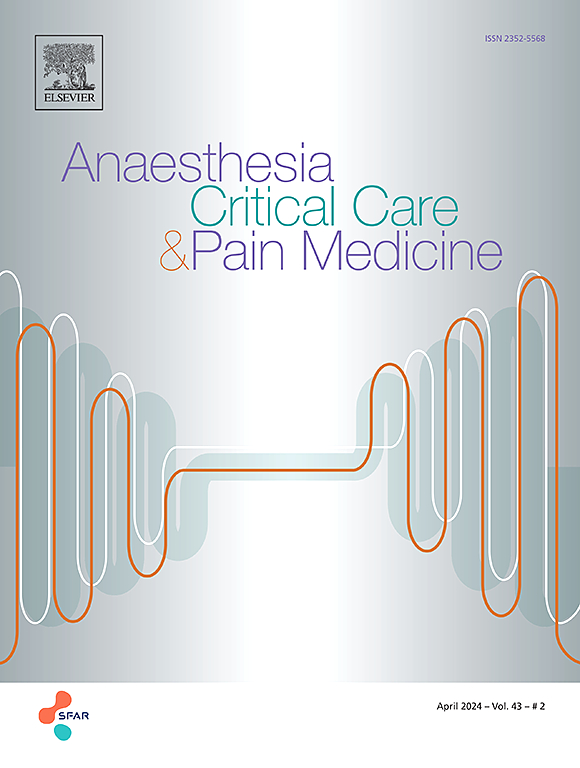A phase 2 open-label pilot study of Remimazolam for sedation in critically ill patients
IF 4.7
3区 医学
Q1 ANESTHESIOLOGY
引用次数: 0
Abstract
Introduction
Remimazolam is a novel benzodiazepine with an ultra-short half-life. It is a potentially interesting alternative for sedation in the Intensive Care Unit, but there is limited data regarding its use in critically ill patients.
Methods
Phase 2, investigator-initiated, single-center, non-randomized, open-label study. Patients with an expected duration of sedation ≥ 24 h were eligible and received a maximum 48-h infusion of Remimazolam, with a dose ranging from 0.1 to 1 mg/min.
The primary endpoint was a composite of the ability to reach a targeted sedation level without the use of another hypnotic drug and hemodynamic stability (no drop in mean arterial pressure ≤ 65 mmHg and no increase in norepinephrine dose ≥ 50% for more than 1 h), during the first 8 h after start. Secondary endpoints included the monitoring of Adverse Events (AE) and pharmacokinetics.
Results
30 patients were included with a median age of 60 [51–70] years, a SAPS II 38 [30–46], and a mortality rate of 23.3%. Fourteen (46.7%) patients met the primary endpoint. Ten (33.3%) patients received Remimazolam for 48 h and 4 (13.3%) patients received the highest dose. 54 AEs were reported in 23 patients and 11 were classified as Serious AEs in 8 patients. Ten AEs were related to Remimazolam. The pharmacokinetics analysis showed steady plasma levels throughout the infusion and rapid elimination after dosing discontinuation.
Discussion
Remimazolam could be useful for sedation in the ICU but deserves further investigation before routine use.
Trial registration
NCT04611425. Registered 2 November 2020.
Remimazolam用于危重患者镇静的2期开放标签试点研究。
简介雷马唑仑是一种新型苯二氮卓类药物,半衰期极短。它是重症监护室镇静剂的潜在替代品,但有关其在重症患者中使用的数据有限:方法:由研究者发起的第二阶段单中心、非随机、开放标签研究。预计镇静持续时间≥ 24 小时的患者均符合条件,并接受最长 48 小时的雷马唑仑输注,剂量为 0.1 至 1 毫克/分钟。主要终点是在开始后的前 8 小时内,在不使用另一种催眠药的情况下达到目标镇静水平的能力和血液动力学稳定性(平均动脉压下降不超过 65 mmHg,去甲肾上腺素剂量增加不超过 50%,持续时间不超过 1 小时)的综合结果。次要终点包括监测不良事件(AE)和药代动力学:共纳入 30 名患者,中位年龄为 60 [51-70] 岁,SAPS II 38 [30-46],死亡率为 23.3%。14名患者(46.7%)达到了主要终点。10名(33.3%)患者接受了48小时的雷马唑仑治疗,4名(13.3%)患者接受了最高剂量的治疗。23名患者报告了54例AE,8名患者的11例AE被归类为严重AE。10 例 AE 与雷美唑仑有关。药代动力学分析表明,在整个输注过程中血浆水平稳定,停药后迅速消除:讨论:雷米马唑仑可用于重症监护室的镇静,但在常规使用前还需进一步研究:试验注册:NCT04611425。注册日期:2020 年 11 月 2 日。
本文章由计算机程序翻译,如有差异,请以英文原文为准。
求助全文
约1分钟内获得全文
求助全文
来源期刊

Anaesthesia Critical Care & Pain Medicine
ANESTHESIOLOGY-
CiteScore
6.70
自引率
5.50%
发文量
150
审稿时长
18 days
期刊介绍:
Anaesthesia, Critical Care & Pain Medicine (formerly Annales Françaises d''Anesthésie et de Réanimation) publishes in English the highest quality original material, both scientific and clinical, on all aspects of anaesthesia, critical care & pain medicine.
 求助内容:
求助内容: 应助结果提醒方式:
应助结果提醒方式:


